Abstract
Considering the very large industrial usage of benzene, studies in risk assessment aimed at the evaluation of carcinogenic risk at low levels of exposure are important. Animal data can offer indications about what could happen in humans and provide more diverse information than epidemiological data with respect to dose-response consideration. We have considered experiments investigating metabolism, short-term genotoxicity tests, DNA adduct formation, and carcinogenicity long-term tests. According to the different experiments, a saturation of benzene metabolism and benzene effects in terms of genotoxicity seems evident above 30 to 100 ppm. Below 30 to 60 ppm the initiating effect of benzene seems to be linear for a large interval of dosages, at least judging from DNA adduct formation. Potential lack of a promoting effect of benzene (below 10 ppm) could generate a sublinear response at nontoxic levels of exposure. This possibility was suggested by epidemiological data in humans and is not confirmed or excluded by our observations with animals.
Full text
PDF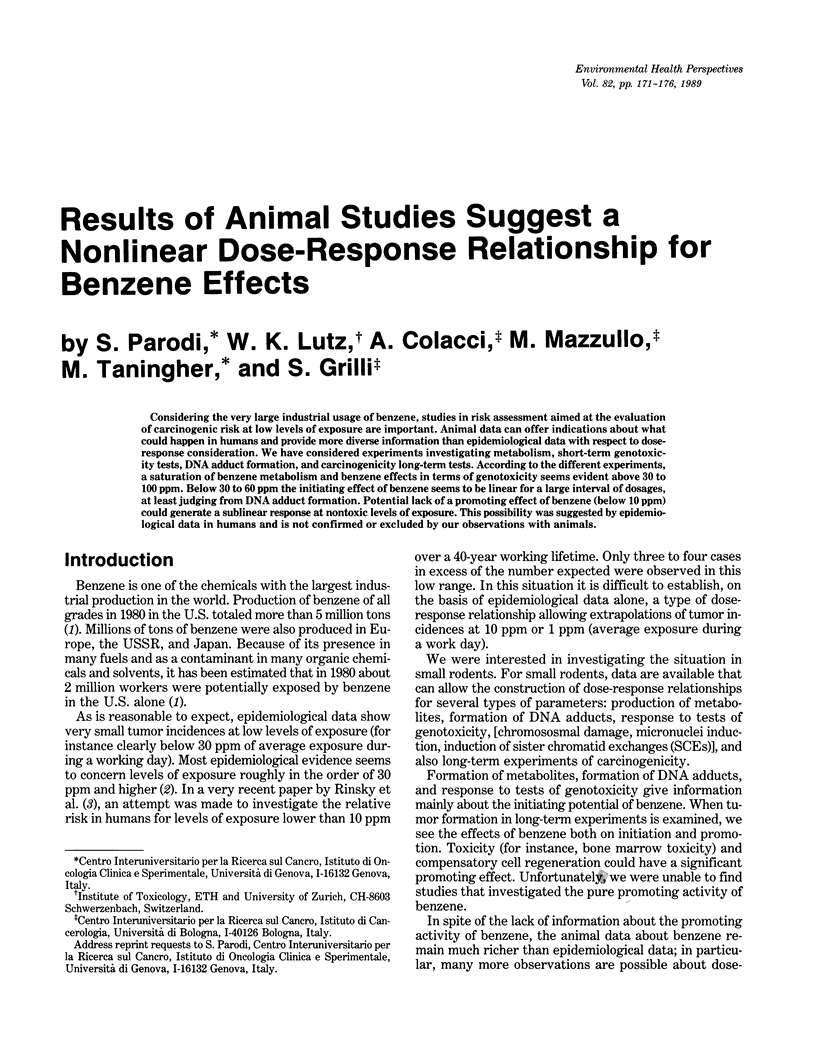
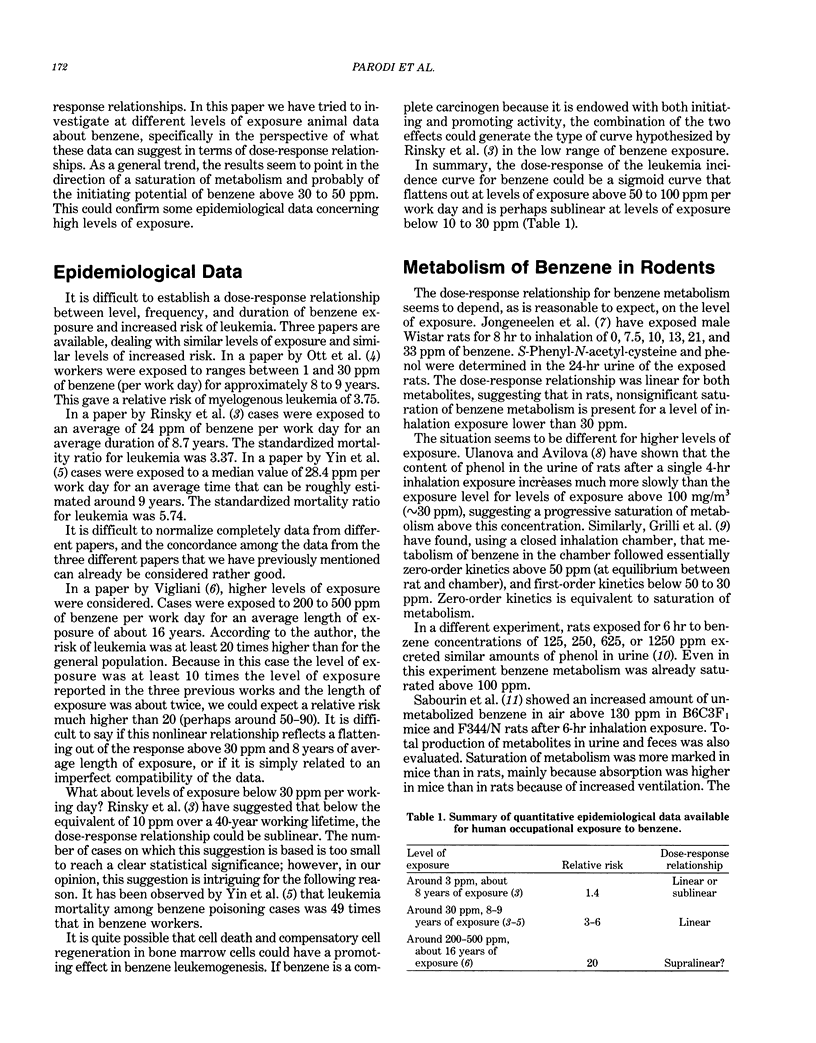
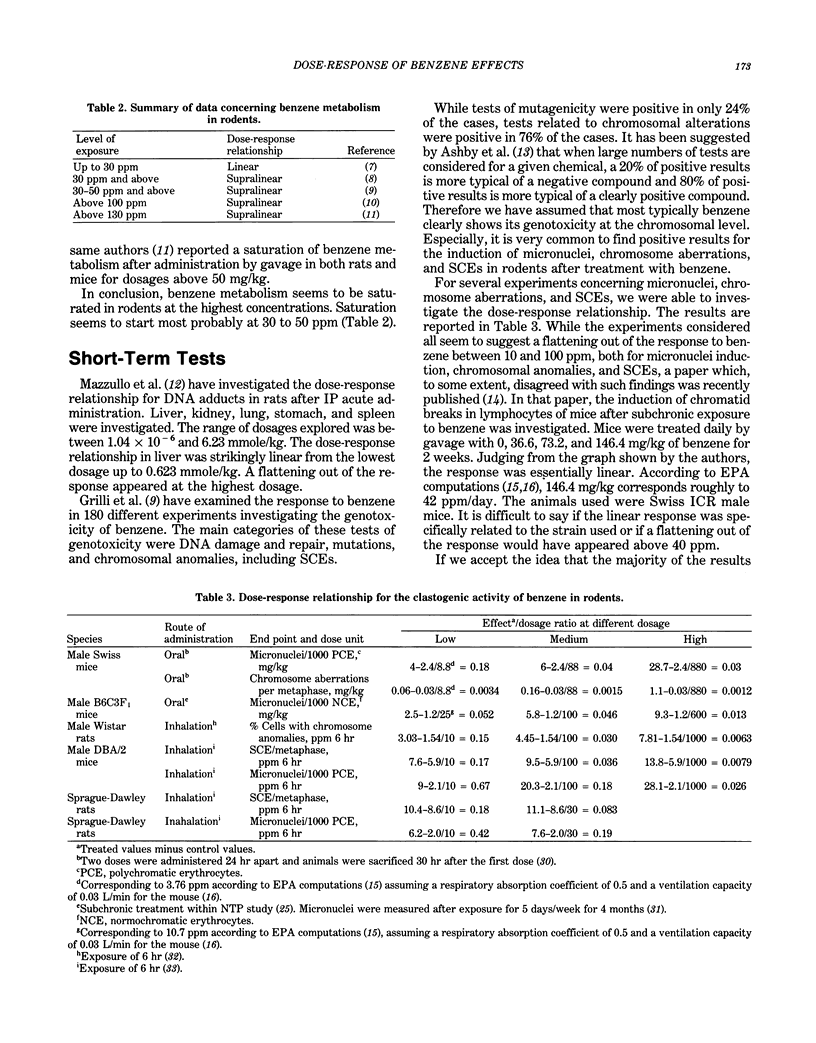
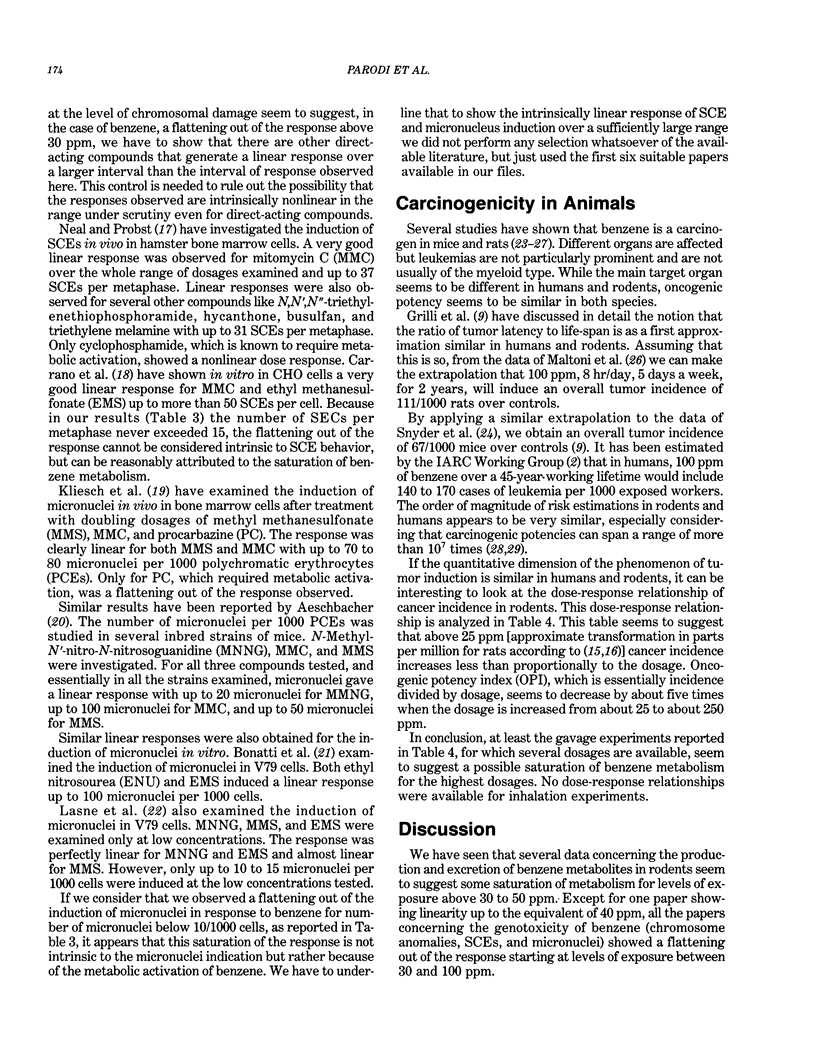
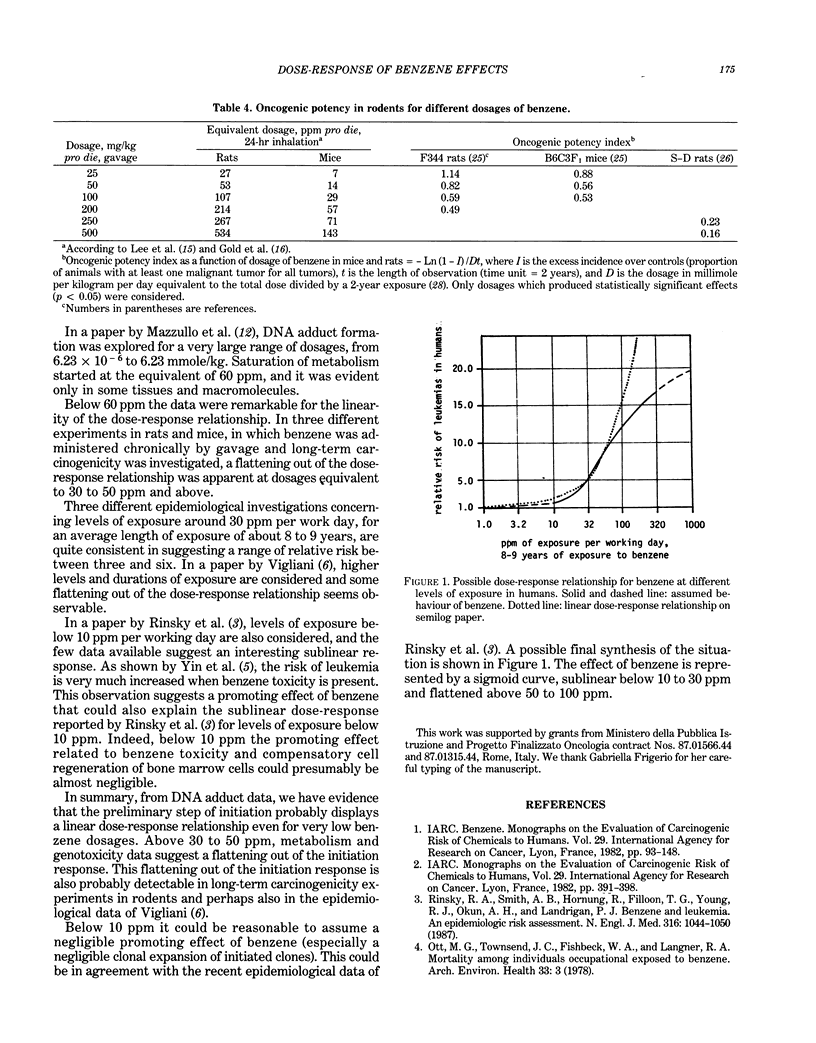
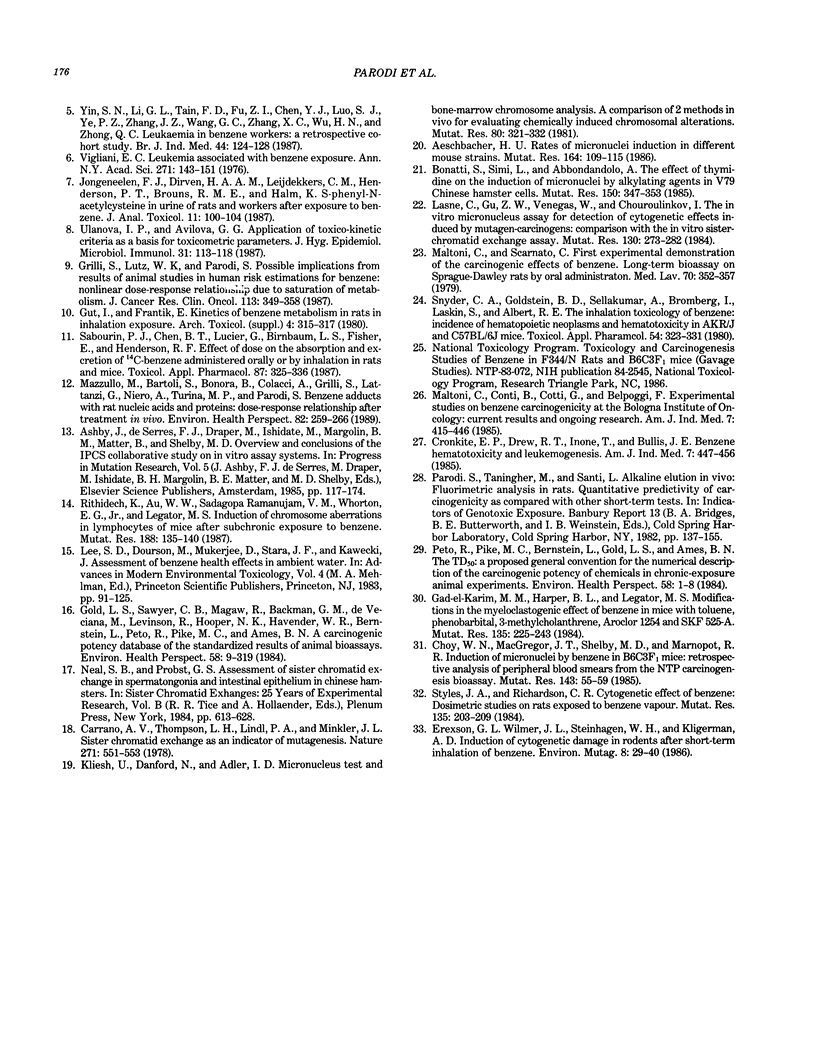
Selected References
These references are in PubMed. This may not be the complete list of references from this article.
- Aeschbacher H. U. Rates of micronuclei induction in different mouse strains. Mutat Res. 1986 Apr;164(2):109–115. doi: 10.1016/0165-1161(86)90049-x. [DOI] [PubMed] [Google Scholar]
- Bonatti S., Simi L., Abbondandolo A. The effect of thymidine on the induction of micronuclei by alkylating agents in V79 Chinese hamster cells. Mutat Res. 1985 Jun-Jul;150(1-2):347–353. doi: 10.1016/0027-5107(85)90131-9. [DOI] [PubMed] [Google Scholar]
- Carrano A. V., Thompson L. H., Lindl P. A., Minkler J. L. Sister chromatid exchange as an indicator of mutagenesis. Nature. 1978 Feb 9;271(5645):551–553. doi: 10.1038/271551a0. [DOI] [PubMed] [Google Scholar]
- Choy W. N., MacGregor J. T., Shelby M. D., Maronpot R. R. Induction of micronuclei by benzene in B6C3F1 mice: retrospective analysis of peripheral blood smears from the NTP carcinogenesis bioassay. Mutat Res. 1985 May-Jun;143(1-2):55–59. doi: 10.1016/0165-7992(85)90105-8. [DOI] [PubMed] [Google Scholar]
- Erexson G. L., Wilmer J. L., Steinhagen W. H., Kligerman A. D. Induction of cytogenetic damage in rodents after short-term inhalation of benzene. Environ Mutagen. 1986;8(1):29–40. doi: 10.1002/em.2860080104. [DOI] [PubMed] [Google Scholar]
- Gad-El-Karim M. M., Harper B. L., Legator M. S. Modifications in the myeloclastogenic effect of benzene in mice with toluene, phenobarbital, 3-methylcholanthrene, Aroclor 1254 and SKF-525A. Mutat Res. 1984 Mar;135(3):225–243. doi: 10.1016/0165-1218(84)90126-5. [DOI] [PubMed] [Google Scholar]
- Gold L. S., Sawyer C. B., Magaw R., Backman G. M., de Veciana M., Levinson R., Hooper N. K., Havender W. R., Bernstein L., Peto R. A carcinogenic potency database of the standardized results of animal bioassays. Environ Health Perspect. 1984 Dec;58:9–319. doi: 10.1289/ehp.84589. [DOI] [PMC free article] [PubMed] [Google Scholar]
- Grilli S., Lutz W. K., Parodi S. Possible implications from results of animal studies in human risk estimations for benzene: nonlinear dose-response relationship due to saturation of metabolism. J Cancer Res Clin Oncol. 1987;113(4):349–358. doi: 10.1007/BF00397718. [DOI] [PubMed] [Google Scholar]
- Gut I., Frantík E. Kinetics of benzene metabolism in rats in inhalation exposure. Arch Toxicol Suppl. 1980;4:315–317. doi: 10.1007/978-3-642-67729-8_64. [DOI] [PubMed] [Google Scholar]
- Jongeneelen F. J., Dirven H. A., Leijdekkers C. M., Henderson P. T., Brouns R. M., Halm K. S-phenyl-N-acetylcysteine in urine of rats and workers after exposure to benzene. J Anal Toxicol. 1987 May-Jun;11(3):100–104. doi: 10.1093/jat/11.3.100. [DOI] [PubMed] [Google Scholar]
- Kliesch U., Danford N., Adler I. D. Micronucleus test and bone-marrow chromosome analysis: a comparison of 2 methods in vivo for evaluating chemically induced chromosomal alterations. Mutat Res. 1981 Feb;80(2):321–332. doi: 10.1016/0027-5107(81)90105-6. [DOI] [PubMed] [Google Scholar]
- Lasne C., Gu Z. W., Venegas W., Chouroulinkov I. The in vitro micronucleus assay for detection of cytogenetic effects induced by mutagen-carcinogens: comparison with the in vitro sister-chromatid exchange assay. Mutat Res. 1984 Aug;130(4):273–282. doi: 10.1016/0165-1161(84)90103-1. [DOI] [PubMed] [Google Scholar]
- Maltoni C., Scarnato C. First experimental demonstration of the carcinogenic effects of benzene; long-term bioassays on Sprague-Dawley rats by oral administration. Med Lav. 1979 Sep-Oct;70(5):352–357. [PubMed] [Google Scholar]
- Mazzullo M., Bartoli S., Bonora B., Colacci A., Grilli S., Lattanzi G., Niero A., Turina M. P., Parodi S. Benzene adducts with rat nucleic acids and proteins: dose-response relationship after treatment in vivo. Environ Health Perspect. 1989 Jul;82:259–266. doi: 10.1289/ehp.8982259. [DOI] [PMC free article] [PubMed] [Google Scholar]
- Ott M. G., Townsend J. C., Fishbeck W. A., Langner R. A. Mortality among individuals occupationally exposed to benzene. Arch Environ Health. 1978 Jan-Feb;33(1):3–10. doi: 10.1080/00039896.1978.10667299. [DOI] [PubMed] [Google Scholar]
- Rinsky R. A., Smith A. B., Hornung R., Filloon T. G., Young R. J., Okun A. H., Landrigan P. J. Benzene and leukemia. An epidemiologic risk assessment. N Engl J Med. 1987 Apr 23;316(17):1044–1050. doi: 10.1056/NEJM198704233161702. [DOI] [PubMed] [Google Scholar]
- Rithidech K., Au W. W., Ramanujam V. M., Whorton E. B., Jr, Legator M. S. Induction of chromosome aberrations in lymphocytes of mice after subchronic exposure to benzene. Mutat Res. 1987 Jun;188(2):135–140. doi: 10.1016/0165-1218(87)90102-9. [DOI] [PubMed] [Google Scholar]
- Sabourin P. J., Chen B. T., Lucier G., Birnbaum L. S., Fisher E., Henderson R. F. Effect of dose on the absorption and excretion of [14C]benzene administered orally or by inhalation in rats and mice. Toxicol Appl Pharmacol. 1987 Feb;87(2):325–336. doi: 10.1016/0041-008x(87)90294-8. [DOI] [PubMed] [Google Scholar]
- Snyder C. A., Goldstein B. D., Sellakumar A. R., Bromberg I., Laskin S., Albert R. E. The inhalation toxicology of benzene: incidence of hematopoietic neoplasms and hematotoxicity in ARK/J and C57BL/6J mice. Toxicol Appl Pharmacol. 1980 Jun 30;54(2):323–331. doi: 10.1016/0041-008x(80)90202-1. [DOI] [PubMed] [Google Scholar]
- Styles J. A., Richardson C. R. Cytogenetic effects of benzene: dosimetric studies on rats exposed to benzene vapour. Mutat Res. 1984 Mar;135(3):203–209. doi: 10.1016/0165-1218(84)90123-x. [DOI] [PubMed] [Google Scholar]
- Ulanova I. P., Avilova G. G. Application of toxico-kinetic criteria as a basis for toxicometric parameters. J Hyg Epidemiol Microbiol Immunol. 1987;31(2):113–118. [PubMed] [Google Scholar]
- Vigliani E. C. Leukemia associated with benzene exposure. Ann N Y Acad Sci. 1976;271:143–151. doi: 10.1111/j.1749-6632.1976.tb23103.x. [DOI] [PubMed] [Google Scholar]
- Yin S. N., Li G. L., Tain F. D., Fu Z. I., Jin C., Chen Y. J., Luo S. J., Ye P. Z., Zhang J. Z., Wang G. C. Leukaemia in benzene workers: a retrospective cohort study. Br J Ind Med. 1987 Feb;44(2):124–128. doi: 10.1136/oem.44.2.124. [DOI] [PMC free article] [PubMed] [Google Scholar]


